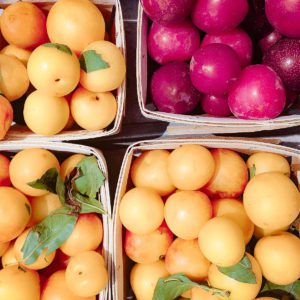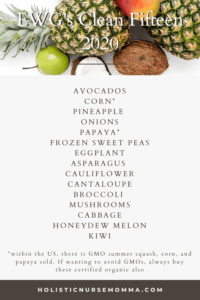Part of being on a plant based diet means, well, we eat a lot of plants! And although no one is perfect and we all find what works best for us, there are definitely some ways to ensure you get the most from what you’re eating. According the EWG’s analysis of the USDA’s latests data, nearly 70% of fresh produce sold in the US contains potentially harmful chemicals.
Round Up is the pesticide sprayed over the food that you eat. You can also buy it to spray weeds in your yard (but please don’t!) In 2018, Monsanto (the creators of RoundUp) were ordered to pay $289 million in damages to a man who had worked as a groundskeeper spraying this toxic sludge then developed cancer.
Why risk eating something that can be avoided and is causing the environment harm in the first place?

WHY WE CHOOSE ORGANIC
We do our best to avoid things like RoundUp in our food. I know what you’re thinking “but Meghan, even conventional organic can use pesticides.” Yes friend, you are right. Unfortunately there are loop holes everywhere and no one is perfect. This is why it’s important that you go to farmers markets or shop locally so you can ask about agricultural practices.
Something else to consider is that the USDA tested raisins for the first time since 2007. The results showed that 99% of non-organic had residue of at least 2 pesticides on them. Eek!
BUT I WILL ADMIT, THERE ARE SOME FOODS I’M NOT SO WORRIED ABOUT BEING ORGANIC
Although organic practices are good for environmental purposes, I don’t mind eating non-organic foods when they have a thick skin or I feel pretty confident that they aren’t produced by GMO seeds (corn, summer squash, oats, and soy are some things I ALWAYS buy organic or I don’t get it). I also take a look at the EWG’s dirty dozen. If you’re never heard about the daily double and the clean fifteen, sit back because I’m about to tell you all about ’em!
The EWG updates their daily dozen and clean fifteen list every year after the Food and Drug Administration and US Department of Agriculture analyze over 35,000 tests. These tests look at the pesticide contamination on 48 popular fruits and vegetables in the United States.
The most contaminated then get listed as the “Dirty Dozen” while the ‘cleanest’ get listed as the “Clean Fifteen”. Here are the 2020 Dirty Dozen and Clean Fifteen results:
The Dirty Dozen
- Strawberries
- Spinach
- Kale
- Nectarines
- Apples
- Grapes
- Peaches
- Cherries
- Pears
- Tomatoes
- Celery
- Potatoes
Bonus Additions
- Sweet Bell Peppers
- Cherry Tomatoes
- Lettuce
- Cucumbers
- Blueberries
- Hot Peppers
I love taking a screenshot or saving a photo on my phone so it’s with me when I grocery shop. So to help you remember which produce to buy organic, I made this little graphic. To save it, hold down on the photo and then ‘save’ it. You can hover over it and pin it to Pinterest or you can hold the power and home button and screen shot it. Whichever is easiest for you!

The Clean Fifteen
- Avocados
- Corn*
- Pineapple
- Onions
- Papaya*
- Frozen Sweet Peas
- Eggplant
- Asparagus
- Cauliflower
- Cantaloupe
- Broccoli
- Mushrooms
- Cabbage
- Honeydew Melon
- Kiwi
Due to wanting to avoid GMO’s, I always buy organic corn. There is also GMO summer squashes and papaya sold in the US. If you’re wanting to avoid GMOs, always buy organic. A requirement for produce to get the USDA certified organic stamp is that the product is non-GMO.

TAKEAWAYS FROM THE EWG’S REPORT
Here are some important points to keep in mind on your next shopping trip:
- When compared to the 2020 Dirty Dozen List, raisins would rank the highest as the highest contaminated with 99% of non-organic raisins having 2 or more pesticides.
- 90% of strawberries, nectarines, apples, and cherries had 2 or more pesticides on them.
- The most common pesticide found on kale is banned in the European Union & listed as a possible human carcinogen in the US. Multiple kale samples had 18 different pesticides.
- All samples are washed and scrubbed before testing, showing that they are not easily washed off.
- The USDA does not test all pesticides used in the US. Unfortunately, they don’t test for glyphosate (AKA RoundUp) the most commonly used pesticide used in the US.
- Glyphosate is used as a pre-harvest drying agent so is being found on increasing more grains and beans (oats and chickpeas being some of the highest).
I wrote this to empower you in knowing which organic vs no-organic foods to buy. As always, I truly believe that eating fresh, none processed produce is best for your health over buying highly processed foods. Decreasing pesticide exposure does improve your health, but as always, do your best. Do what works best for you and your family.
Going to plants from a highly processed diet does seem more expensive. But if you think about the health, energy, and better mood that plants bring, can you really put a price tag on all of that? I don’t think so which is why I want to help you live your happiest, healthiest life.
If you want to read on the EWG’s dirty dozen and clean fifteen along with the report, you can find them all here.

Leave a Reply